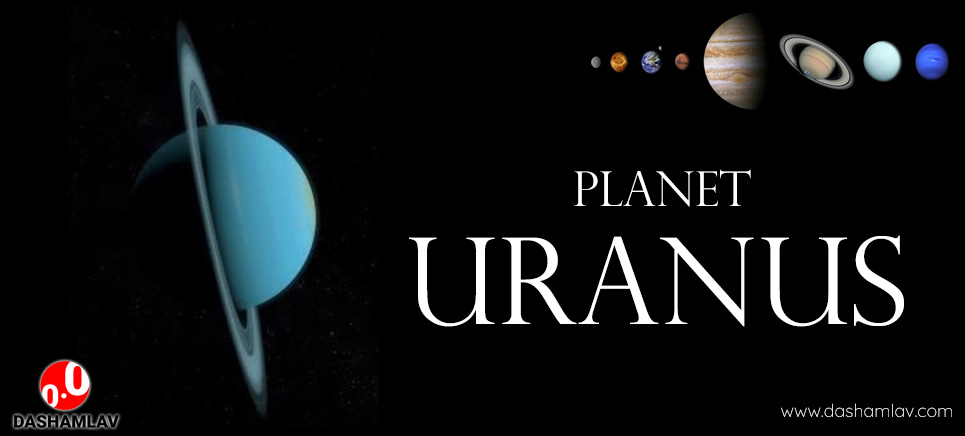In our solar system, Uranus is the seventh planet from the Sun. It is one of the gas giant planets — but because of difference in chemical composition, Uranus and Neptune are also often classified as ice giants. Uranus is the third largest planet by size and fourth largest by mass. The planet has been named after the Greek god Uranus — who is the grandfather is Zeus (Jupiter) and father of Saturn (Cronus). Here are some interesting facts about Uranus.
1. Coldest Planet
Temperature on Uranus can go as low as −224 °C (−371 °F) making it the coldest place in the solar system. Although Neptune is farther from the Sun, Uranus is still the coldest. (Did you know which is the hottest planet? It’s Venus! and not Mercury)
2. Sideways Planet
Uranus is also known as the sideways planet because it orbits around Sun sideways. This is because the axial tilt of Uranus is 97.7° to its orbit. The poles of Uranus lie almost where other planets have their equator.
3. Uranus has Retrograde Rotation
Uranus rotates on its axis in retrograde direction — that is opposite direction of earth and most of the other planets. Uranus rotates from east to direction. (Did you know which other planet rotates in the same direction? Well, again it is Venus!)
4. Uranus is Featureless
Uranus appears to have light blue and almost featureless surface in visible light. There are no storms or clouds visible as in case of Jupiter and Saturn. Presence of methane in Uranus atmosphere gives the planet its blue color.
5. Day of Uranus is Shorter than that of the Earth — but not!
Uranus completes one rotation on its axis in 17 hours and 14 minutes. However, axis of Uranus is so heavily tilted that its poles directly face the Sun. Uranus completes one orbit around the Sun in 84 Earth years. As a result, the daylight time on the pole of Uranus is 42 years followed by a 42 years long night-time.

6. Only One Spacecraft has Ever Visited Uranus
Voyager 2 is the only spacecraft that flew by Uranus. On 24 January 1986, Voyager 2 came within 81,500 km (50,600 mi) of the cloudtops of Uranus.
7. Uranus has Many Moons
Uranus, like other gas giants, has numerous moons. So far 27 moons of Uranus have been discovered. Names of the moons of Uranus are taken from the characters in the works of Shakespeare and Alexander Pope. The five main satellites of Uranus are Miranda, Ariel, Umbriel, Titania, and Oberon.
8. Uranus has Rings!
Many people think that Saturn is the only planet with ring system. It is true that Saturn’s rings are most elaborate and beautiful — but the fact is that all four gas giant planets have their own ring systems. So far thirteen rings of Uranus have been counted. These rings are composed of very dark particles and are less than a meter wide. This is the reason why Uranian rings are not easily visible.
9. First Planet Discovered in Modern Age
Bright planets (like Mercury, Venus, Jupiter, Saturn etc.) visible to unaided eyes have been known to mankind since ancient times. Uranus is first among those which have been discovered in the modern age. Observations by Sir William Herschel in 1781 confirmed that Uranus was not a star but actually a planet.
10. Uranium was Named after Uranus
Uranium was discovered in 1789, eight years after the discovery of Uranus. The new planet was honored by naming the new element in the periodic table as Uranium.
Statistics about Planet Uranus
| PROPERTY | VALUE |
|---|---|
| Radius of Uranus | 25,559 km |
| Surface area of Uranus | 8.1156 ×109 km2 (15.91 Earths) |
| Volume of Uranus | 6.833×1013 km3 (63.086 Earths) |
| Mass of Uranus | 8.6810×1025 kg (14.536 Earths) |
| Mean density | 1.27 g/cm³ |
| Perihelion (closest distance to Sun) | 18.33 AU |
| Aphelion (farthest distance from Sun) | 20.11 AU |
| Length of solar day (single rotation on its axis) | 17 h 14 min 24 s |
| Length of year (single revolution around the Sun) | 84.0205 Earth years |
| Equatorial inclination to orbit (axial tilt) | 97.77° (to orbit) |
| Rotation speed at Equator | 2.59 km/s (9,320 km/h) |
| Surface gravity | 8.69 m/s2 |
| Escape velocity | 21.3 km/s |
| Natural satellite | So far, Uranus has 27 known natural satellites including Miranda, Ariel, Umbriel, Titania, and Oberon |
| Composition of Uranus | Gases
Ices
|
Use the citation below to add this article to your bibliography
"Planet Uranus: Facts about the Coldest Planet in the Solar System." Dashamlav.com. Web. 12 June 2025. <https://dashamlav.com/uranus-facts-coldest-planet/>
Dashamlav.com, "Planet Uranus: Facts about the Coldest Planet in the Solar System." Accessed 12 June 2025. https://dashamlav.com/uranus-facts-coldest-planet/
"Planet Uranus: Facts about the Coldest Planet in the Solar System." (n.d.). Dashamlav.com. Retrieved 12 June 2025 from https://dashamlav.com/uranus-facts-coldest-planet/
